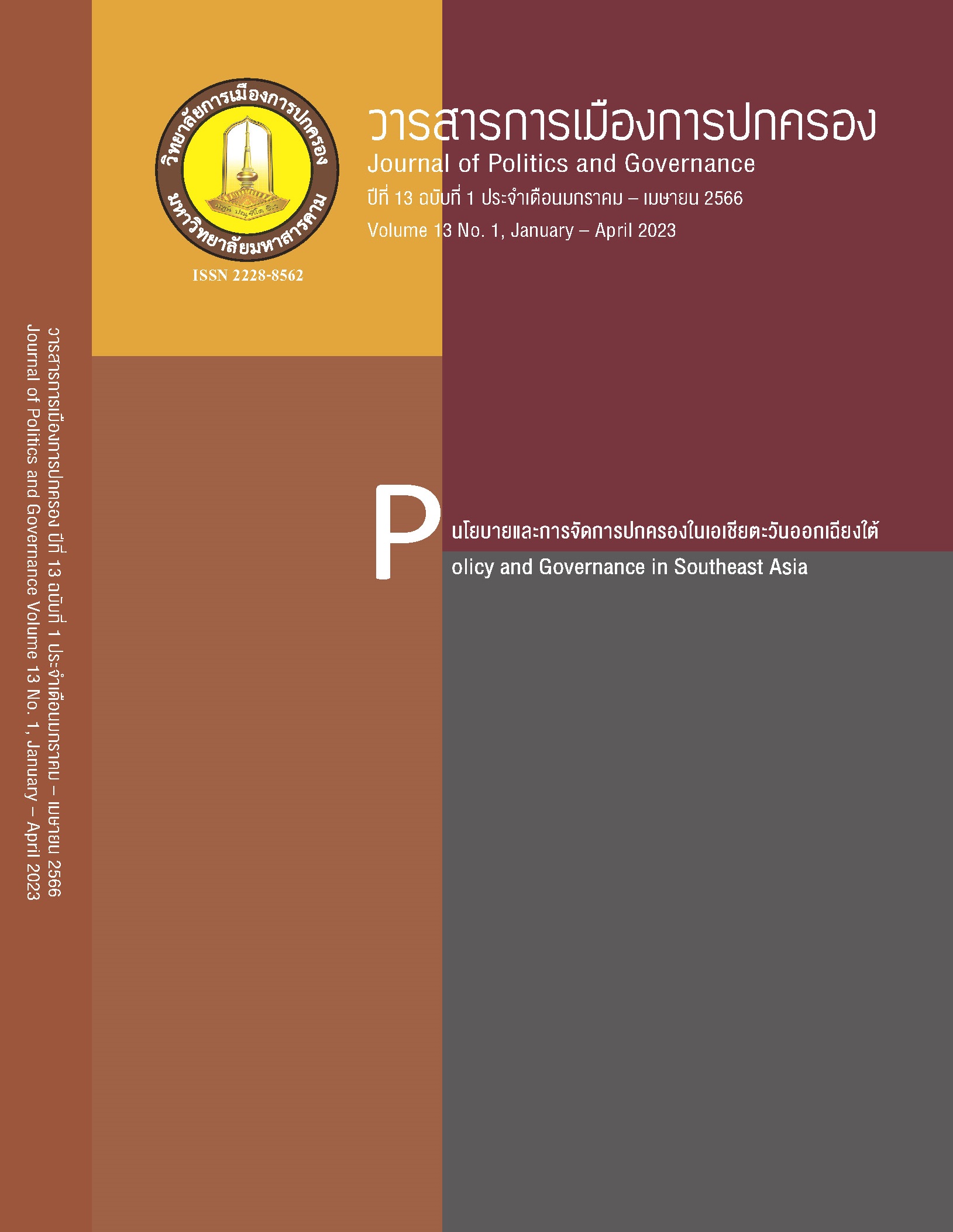Constitutional Court: Criticism of Problems and Obstacles of Political Judicial Power in Thai Society
Main Article Content
Abstract
The purpose of this academic article is to analyze the problems and obstacles of constitutional court on using the political judiciary during the time where it was in the form of a juridical committee, and then developed to be a legal organization the in the form of the court. The researcher acquired the information through literature review in order to analyze the background of this body, its development, and authority that maintained the supremacy of the constitution, including important problems during the time where it was in the abovementioned forms. The result suggested that 1) the development of body authorized to interpret constitutional laws could be divided into four aspects, i.e., the acceptance of the authority to interpret the laws from the parliament; the mutual authority of the parliament and the judicial committee; the sole use of authority of judicial committee; and the use of authority in the form of the court, 2) the authority could be classified into tree characteristics, i.e., the authority that controlled individuals, organizations, and laws to prevent any actions or legal stipulations contradictory to the constitutional laws, 3) regarding important problems and obstacles, they depended on the form which exercises the authority; during the time where it was in form of a judicial committee, the problems were related to recruitment, organizational structure, term of office, and independency, whilst the problems during the time where it was transformed to a court form were related to qualifications, number of committee members and their background, ethics, and qualification validation process. These problems affected the performance of the duties to protect the constitution.
Article Details
References
กระมล ทองธรรมชาติ และ เชาวนะ ไตรมาส. (2547). วิวัฒนาการของระบอบรัฐธรรมนูญไทยจากอดีตถึงปัจจุบัน. กรุงเทพฯ: สำนักพิมพ์บรรณกิจ.
กมลชัย รัตนสกาววงศ์. (2538). ศาลรัฐธรรมนูญและวิธีพิจารณาคดีรัฐธรรมนูญ. วารสารนิติศาสตร์, 25(1), (มีนาคม 2538).
ชัยอนันต์ สมุทวณิช. (2543). วิสัยทัศน์ไทยในสังคมโลก. กรุงเทพฯ: สำนักพิมพ์อมรินทร์.
ธุวพล ทองอินทราช. (2554). บทบาทของศาลรัฐธรรมนูญต่อการพัฒนาการเมืองไทย. (วิทยานิพนธ์รัฐศาสตรมหาบัณฑิต). มหาวิทยาลัยเชียงใหม่.
นงเยาว์ ปัญญา. (2547). เขตอำนาจระหว่างศาลรัฐธรรมนูญกับศาลปกครอง. (วิทยานิพนธ์นิติศาสตรมหาบัณฑิต). มหาวิทยาลัยธรรมศาสตร์.
บุญศรี มีวงศ์อุโฆษ. (2549). กฎหมายรัฐธรรมนูญ. กรุงเทพฯ: สำนักพิมพ์มหาวิทยาลัยธรรมศาสตร์.
บรรเจิด สิงคะเนติ. (2544). ความรู้ทั่วไปเกี่ยวกับศาลรัฐธรรมนูญ. กรุงเทพฯ: สำนักพิมพ์วิญญูชน.
บวรศักดิ์ อุวรรณโณ. (2538). คำอธิบายกฎหมายมหาชน (เล่ม 3) ที่มาและนิติวิธี. กรุงเทพฯ: สำนักพิมพ์นิติธรรม.
ผดุงพันธ์ จันทโร. (2544). ศาลรัฐธรรมนูญกับกระบวนการตรวจสอบอำนาจรัฐตามรัฐธรรมนูญแห่ง ราชอาณาจักรไทยพุทธศักราช 2540. (วิทยานิพนธ์รัฐศาสตรมหาบัณฑิต). มหาวิทยาลัยธรรมศาสตร์.
พงษกร กิตติทรงภพ. (2545). ปัญหาทางกฎหมายในกระบวนการสรรหาและเลือกตุลาการศาลรัฐธรรมนูญ. (วิทยานิพนธ์นิติศาสตรมหาบัณฑิต). มหาวิทยาลัยรามคำแหง.
รังสิกร อุปพงศ์. (2547). สถาบันตุลาการและกระบวนการยุติธรรม (พิมพ์ครั้งที่ 4). นนทบุรี. สำนักพิมพ์มหาวิทยาลัยสุโขทัยธรรมาธิราช.
วิษณุ เครืองาม. (2530). กฎหมายรัฐธรรมนูญ (พิมพ์ครั้งที่ 3). กรุงเทพฯ: จุฬาลงกรณ์มหาวิทยาลัย.
วรเจตน์ ภาคีรัตน์. (2550). รายงานการวิจัย เรื่อง การเปลี่ยนแปลงแนวคำวินิจฉัยและผลผูกพันคำวินิจฉัย ศาลรัฐธรรมนูญ: ศึกษากรณีศาลสูงสุดของสหรัฐอเมริกาและศาลรัฐธรรมนูญแห่งสาธารณรัฐเยอรมัน. กรุงเทพฯ: สำนักงานศาลรัฐธรรมนูญ.
วลัยมาศ แก้วศรชัย. (2541). สภาร่างรัฐธรรมนูญกับการร่างรัฐธรรมนูญตามแนวรัฐธรรมนูญนิยม.(วิทยานิพนธ์นิติศาสตรมหาบัณฑิต). จุฬาลงกรณ์มหาวิทยาลัย.
วิรัช วิรัชนิภาวรรณ. (2552). ความสัมพันธ์ระหว่างอำนาจตุลาการกับการบริหารราชการไทย (พิมพ์ครั้งที่ 7). นนทบุรี. สำนักพิมพ์มหาวิทาลัยสุโขทัยธรรมาธิราช.
รัฐธรรมนูญแห่งราชอาณาจักรไทยพุทธศักราช 2560. สืบค้นจาก http://www.ratchakitcha. soc.go.th /DATA/PDF/2560/A/040/1.PDF
สุปรีญา นุ่นเกลี้ยง. (2547). ปัญหาและอุปสรรคของศาลรัฐธรรมนูญในการตรวจสอบการใช้อำนาจรัฐของผู้ดำรงตำแหน่งทางการเมือง. (วิทยานิพนธ์รัฐศาสตรมหาบัณฑิต). สาขาวิชาการเมืองและการปกครอง มหาวิทยาลัยเชียงใหม่.
สมคิด เลิศไพฑูรย์. (2535). องค์ประกอบของคณะตุลาการรัฐธรรมนูญในประเทศไทย. กรุงเทพฯ: คณะนิติศาสตร์ มหาวิทยาลัยธรรมศาสตร์.
สมคิด เลิศไพฑูรย์. (2540). กฎหมายรัฐธรรมนูญ: หลักการใหม่ตามรัฐธรรมนูญแห่งราชอาณาจักรไทย พุทธศักราช 2540. กรุงเทพฯ: สำนักพิมพ์มหาวิทยาลัยธรรมศาสตร์.
สมชาย ปรีชาศิลปกุล. (2550). อภิรัฐธรรมนูญไทย. กรุงเทพฯ: สถาบันปรีดี พนมยงค์.
สำนักงานศาลรัฐธรรมนูญ. (2548). ศาลรัฐธรรมนูญกับการคุ้มครองสิทธิและเสรีภาพของประชาชน. กรุงเทพฯ: สำนักงานศาลรัฐธรรมนูญ.
สุรพล นิติไกรพจน์, และคณะ. (2546). ศาลรัฐธรรมนูญกับการปฏิบัติพันธกิจตามรัฐธรรมนูญ. กรุงเทพฯ: สำนักพิมพ์วิญญูชน.
สุวิทย์ ธีรพงษ์. (2541). ศาลรัฐธรรมนูญ ผู้พิทักษ์รักษารัฐธรรมนูญ. กรุงเทพฯ: สำนักพิมพ์สุขภาพใจ.
อมร จันทรสมบูรณ์. (2536). ศาลรัฐธรรมนูญ. วารสารกฎหมายปกครอง, 12(3), (ธันวาคม 2536).
อมร รักษาสัตย์, และคณะ. (2543). ประชาธิปไตย อุดมการณ์ หลักการ และแบบอย่าง การปกครองหลายประเทศ (พิมพ์ครั้งที่ 2). กรุงเทพฯ: สำนักพิมพ์แห่งจุฬาลงกรณ์มหาวิทยาลัย.


